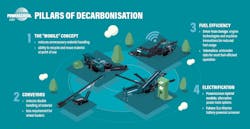Powerscreen Unveils Battery-powered Screener Concept
Terex brand Powerscreen has unveiled a battery-powered screener concept called the Eco-Warrior.
Working with automotive technology and using efficient drives and intelligent control systems, the Eco-Warrior battery powered screener has been designed to be a self-charging, or plug-in, model that features a simple, quiet engine with no aftertreatment requirements. The required engine size has been cut in half compared with the diesel hydraulic unit and the battery pack can mean emission-free running or give a power boost, the company says.
“To the best of our knowledge this is the first battery-powered screener in the world and has been clocking up testing hours since it was built in 2019," says Neil Robinson, Powerscreen product and applications manager. "It still delivers on the powerful screening action that Powerscreen machines are famous for and we are now exploring taking it from concept to mainstream.
"Some may view this topic as a recent trend, but for Powerscreen, decarbonization is multifaceted and has always been at our core," Robinson says. "The Powerscreen mobile concept has always contributed towards decreasing the carbon footprint per ton of material produced. This is done by reducing unnecessary material handling of hauling and loading material to static plants in aggregate production or in the ability to recycle and reuse material at point of use, for example in roadbuilding projects where subbase material is produced in situ. Using stockpiling conveyors as part of a track mobile setup is another perfect example of how to cut out unnecessary double handling, reducing fuel consumption and therefore carbon production.”
Powerscreen says it has evolved its product range to reduce environmental impact by making its crushing and screening equipment as fuel efficient as possible, using direct-drive systems for its crushing range and improving engine capabilities and driveline design for its screening range.
“Direct-drive systems are proven to be 13 to 18 percent more fuel efficient when compared with hydrostatic, resulting in significantly less carbon emissions, while improvements to our screening range has reduced engine speeds from 2,200 rpm to 1,800 rpm, which not only means cleaner engines with less emissions, but also reduced fuel usage and therefore carbon produced," Robinson says. "For example, a typical mid-size screener running at 1,000 hours per year, has a fuel usage reduction of approximately 450 liters, which equates to 1.2 tons less of carbon produced annually.”
Electrification is currently a key focus of the the company's decarbonization strategy. The Powerscreen Hybrid range, designed to give customers alternative energy options to operate their range of crushing, screening and conveying equipment, has been enhanced to include more fully electric crushers and screeners as well as models powered by combinations of diesel and electricity. These options enable customers to choose which fuel to use, depending on cost, location and availability, and are of particular benefit to customers who operate in an area where electricity is more cost effective than diesel fuel, where diesel engine noise is unwanted, or on sites where electricity is the preferred energy source.
“Customers using Powerscreen Hybrid units powered off the grid have been able to reduce onsite carbon emissions by 57 percent per ton of material produced," Robinson says. "While our hybrid customers have traditionally been in environmentally conscious countries and states where legislation or financial incentives are more focused on green energy, we are witnessing a significant uptake in nontraditional locations, as customers prepare to comply with increased government drives for carbon neutrality.”
